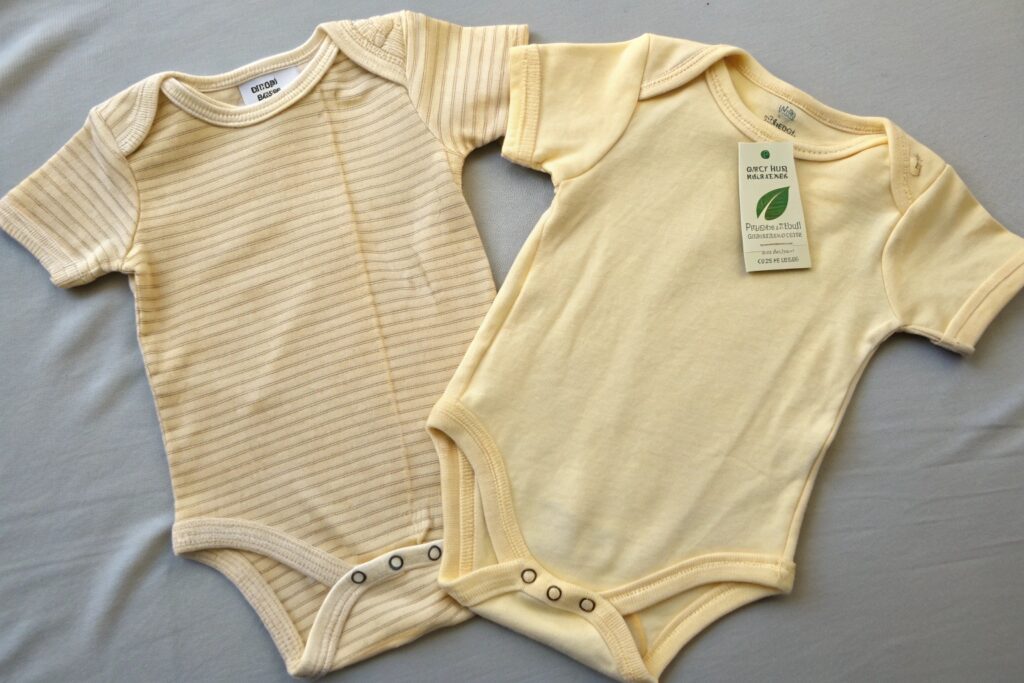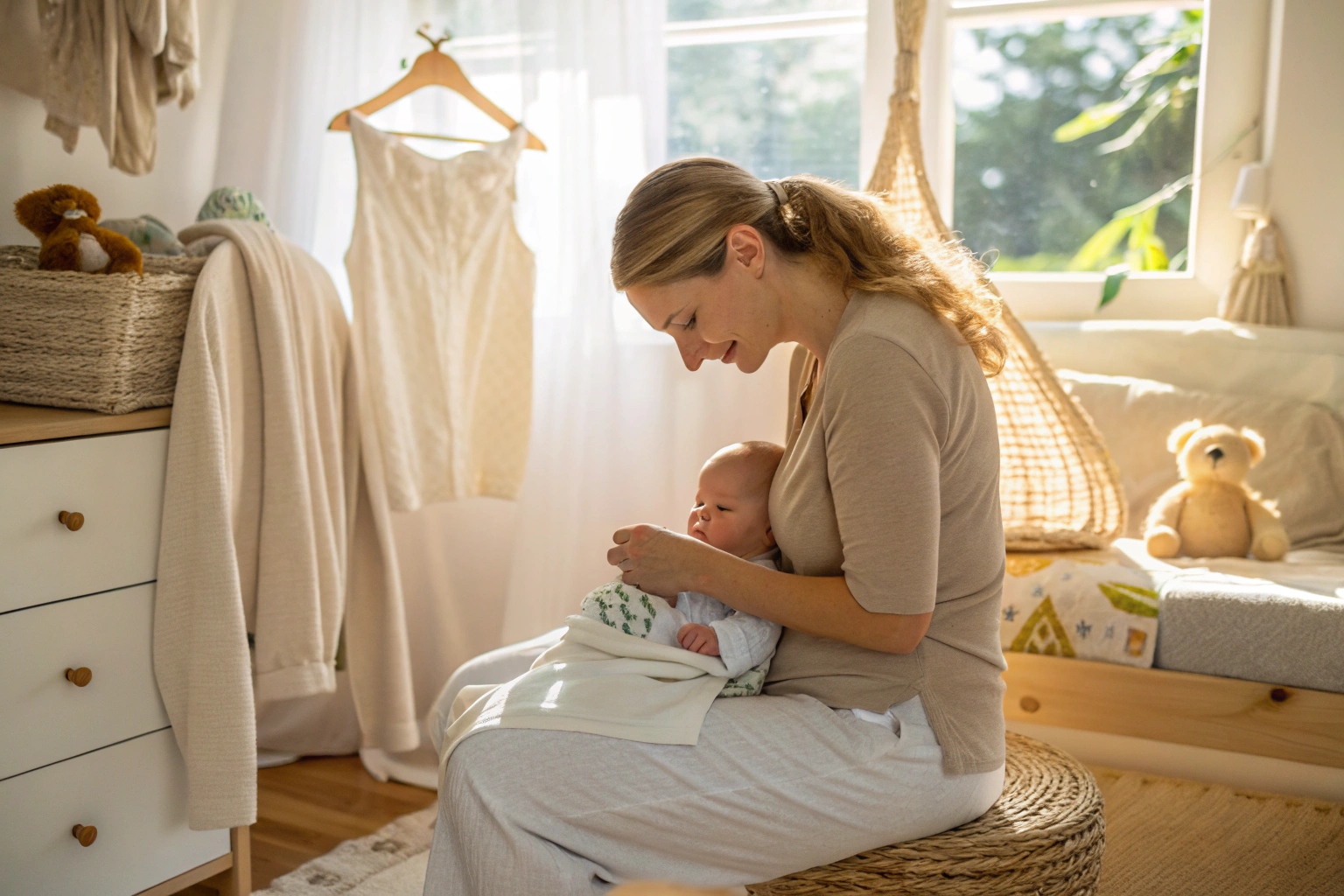New parents want the best for their babies—but with so many clothing options out there, it’s easy to feel lost.
Organic baby clothes are best for babies because they avoid harsh chemicals, feel gentler on the skin, and support long-term health.
That’s why I always go back to organic when choosing clothing for my baby clients. Let’s explore what really makes organic clothing stand out.
Why is organic clothing good for babies?
Many baby clothes look soft and harmless, but that doesn’t mean they’re safe.
Organic clothing is good for babies because it’s made without toxic chemicals and is gentler on sensitive skin.

How do chemicals in conventional baby clothing affect a baby’s health?
Most conventional baby clothes are made from cotton grown with pesticides or synthetics like polyester. These materials may be treated with:
- Formaldehyde (used for anti-wrinkle finish)
- Phthalates (used for prints)
- Azo dyes (used for coloring)
For babies, even small exposures can matter. Their skin is thinner, more absorbent, and still developing. I’ve heard from parents whose babies developed unexpected rashes, only to discover it was from their onesies.
Organic cotton eliminates these risks. It’s farmed without synthetic pesticides and processed without toxic treatments. That means less chance of skin irritations or allergic reactions.
Here’s a comparison table:
| Feature | Conventional Cotton | Organic Cotton |
|---|---|---|
| Pesticide Use | High | None |
| Chemical Processing | Yes (bleach, dyes, resin) | Limited and natural methods |
| Skin Irritation Risk | Moderate to High | Very Low |
| Biodegradable | Partially | Fully |
Does organic baby clothing last longer than regular ones?
Yes, in my experience, organic clothes often hold up better. Because they don’t use aggressive chemicals, the fabric structure stays intact longer. This means fewer rips, softer touch even after washes, and less fading.
As someone who helps brands build long-term supply chains, I always recommend going organic for baby lines—it saves money and improves customer trust.
Is organic products good for babies?
It’s tempting to think “organic” is just a marketing word.
But organic products, especially clothing, reduce exposure to harmful chemicals, support sensitive skin, and promote overall well-being for babies.

What makes organic baby products safer and more trustworthy?
Organic certification isn’t just a label—it’s a strict process. Trusted certifications like GOTS (Global Organic Textile Standard) require:
- No harmful dyes or heavy metals
- No chlorine bleach
- Safe working conditions for laborers
- Wastewater treatment during production
For babies, these standards mean they’re not inhaling or absorbing harmful residues. I’ve handled many supplier audits and seen firsthand how certified organic factories maintain hygiene, environmental, and social compliance.
Here’s a typical checklist I use when sourcing organic babywear:
- ✅ GOTS certification
- ✅ No synthetic fragrance
- ✅ Nickel-free snaps and buttons
- ✅ Natural dyes only
- ✅ Fabric softness rating
Do organic baby clothes cost more?
Usually, yes—but only slightly. And the difference is worth it. You get transparency, cleaner materials, and long-term health protection.
Plus, when I work with American buyers like Ron, they often discover parents are happy to pay a few dollars more for better quality and peace of mind. This builds a more loyal customer base and fewer returns due to allergies or defects.
What is the healthiest fabric for babies?
Some fabrics may look soft, but not all are safe or breathable.
The healthiest fabric for babies is certified organic cotton—breathable, chemical-free, and naturally hypoallergenic.

Why is organic cotton better than bamboo or synthetic fabrics?
Let’s compare the top options:
| Fabric Type | Chemical-Free | Breathable | Hypoallergenic | Durable | Common Concerns |
|---|---|---|---|---|---|
| Organic Cotton | ✅ Yes | ✅ High | ✅ Yes | ✅ Yes | Price slightly higher |
| Bamboo Viscose | ❌ No | ✅ High | ❌ No | ✅ Yes | Often heavily processed |
| Polyester | ❌ No | ❌ Low | ❌ No | ✅ Yes | Traps heat, causes sweating |
| Wool | ✅ Usually | ✅ High | ❌ No | ✅ Yes | May irritate baby skin |
Many new brands advertise bamboo as “eco-friendly,” but bamboo rayon often involves toxic chemicals like carbon disulfide. It’s a misleading greenwash.
I tell my clients to stick to GOTS-certified organic cotton—no ambiguity, no risk.
Is there a difference in softness between fabrics?
Yes. Softness isn’t just a luxury—it’s critical for babies. Organic cotton becomes even softer with each wash, while synthetic blends often get rougher or pill over time.
For newborns and infants with eczema or diaper rash, soft organic cotton reduces friction and promotes healing. Parents often notice calmer sleep and fewer fusses when switching to organic.
What is the best type of clothing suitable for a baby?
Not all cute baby clothes are practical—or healthy.
The best type of clothing for babies is breathable, stretchy, free from toxic chemicals, and easy to put on and take off.

What clothing designs are safest and most functional for babies?
Babies wriggle, spit up, and need frequent diaper changes. So their clothes must be:
- Easy to fasten: Zippers or snaps instead of buttons
- Tagless: No scratchy labels inside
- Neck openings: Stretchy or envelope-style to fit over heads easily
- Natural color: No excess dyes or glitter
- Secure fits: No loose ribbons, hoods, or choking hazards
I help buyers design organic babywear collections with minimal seams, side snaps, and fold-over mittens. These thoughtful features reduce skin irritation and support better mobility.
Here’s a simple design checklist:
| Feature | Good Choice | Avoid |
|---|---|---|
| Fabric | Organic cotton | Polyester blends |
| Fasteners | Nickel-free snaps | Decorative buttons |
| Neckline | Envelope style | Tight crew necks |
| Labels | Printed or tagless | Stitched-on itchy tags |
| Add-ons | Simple and secure | Ribbons, beads, sequins |
How does clothing impact a baby’s body temperature?
Babies can’t regulate temperature well. Clothes that trap heat or lack breathability may cause overheating, leading to discomfort or even health risks.
Organic cotton naturally allows airflow, wicks moisture, and doesn’t stick to the body. Whether it’s summer or winter, I’ve found cotton layers to be the safest choice. For colder months, I recommend layering organic bodysuits with wool covers—but only if the wool is certified and ultra-soft.
Conclusion
Organic baby clothes protect sensitive skin, avoid harmful chemicals, and support long-term health. For parents and buyers alike, they’re a smart, safe, and ethical choice.










